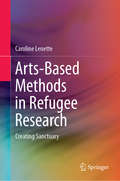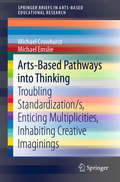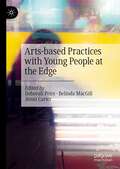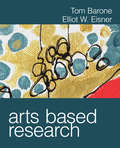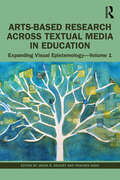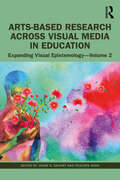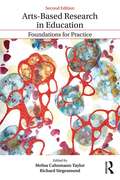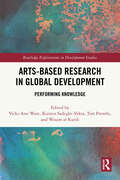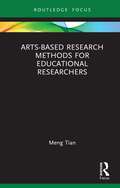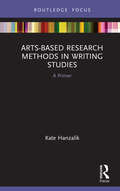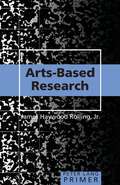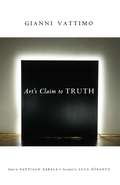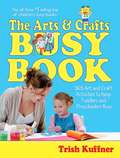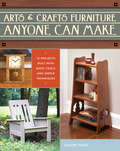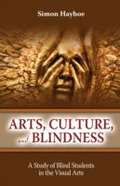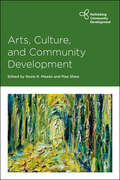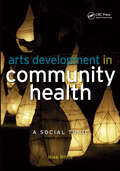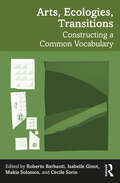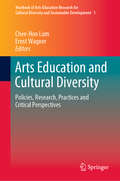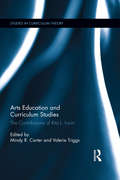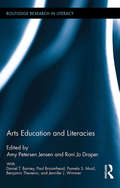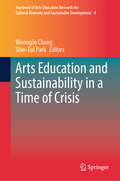- Table View
- List View
Arts-Based Methods in Refugee Research: Creating Sanctuary
by Caroline LenetteDrawn from a decade of refugee studies, this book offers a wealth of insights on arts-based methodologies. It explores exciting new prospects for participatory and culturally safe research, and will be a reference resource for researchers of all levels and community practitioners.The book tackles questions of meaningful research practice: How do people with lived experiences of forced migration—Knowledge Holders—lead the way? Can arts-based methods bring about policy and social change? And what of ethical issues?By reflecting on the strengths and limitations of four research methods (digital storytelling, photography, community music, and participatory video), readers are invited to craft their own approach to arts-based projects.
Arts-Based Pathways into Thinking: Troubling Standardization/s, Enticing Multiplicities, Inhabiting Creative Imaginings (SpringerBriefs in Arts-Based Educational Research)
by Michael Crowhurst Michael EmslieThis book, based on a critical/collective/auto/ethnographic research project, describes an assemblage of theoretically informed, arts-based methods that aim to promote multiplicity and thinking. It explores multiplicities of knowing, sensing, doing and being, generated by analyzing knowing frames, poetry, reading aloud, fableing, playwriting and other inventive, playful and scholarly ways of working with experiences and stories. By offering engaging and inspiring strategies that can disturb standardizations and interrupt cultural normativities, the book sheds light on the conditions that might be present in cultural contexts that enable diversity and creativity. The research project on which this book is based originated from a contradictory set of conditions characterized on the one hand by a marked interest in creative research methods and novel knowledge practices and, on the other hand, by a widespread concern that we live in increasingly standardized times, featuring systems that specify objectives ahead of time, demand compliance and narrow the possibilities for human action. The book takes readers on an arts-based journey designed to enhance the opportunities for imaginative and ethical professional practice in education, human services and the arts.
Arts-based Practices with Young People at the Edge
by Deborah Price Belinda MacGill Jenni CarterThis book explores how arts-based programs designed to reconnect young people with learning and work provide brief, sometimes profound, re-engagements and productive identity shifts. It aims to support youth pushed to the edge of formal education and entangled in structural social and cultural inequality. The researchers, artists, activists, and youth organizations developed process-oriented practices with young people, enacting new creative methodologies building on agentive possibilities to disrupt misrepresentation and invisibility. The book positions arts-based practices at the edge, examining complex systemic issues around youth disengagement and possibilities of collective creativity to navigate broken systems and inform futures. Enacting arts-based methodologies with young people at the edge through co-design shares navigation out of locked trajectories in collaboration with those who listen deeply as allies in their journey of re-presenting themselves to the world. The final section reflects on arts-based practices at the edge eliciting standpoints of young people at the edge.https://link.springer.com/
Arts Based Research
by Elliot W. Eisner Tom BaroneArts Based Research is ideal for students, researchers, and practitioners. This unique book provides a framework for broadening the domain of qualitative inquiry in the social sciences by incorporating the arts as a means of better understanding and rethinking important social issues. In the book′s 10 thought-provoking chapters, authors Tom Barone and Elliot W. Eisner--pioneers in the field--address key aspects of arts based research, including its purpose and fundamental ideas, controversies that surround the field and the politics and ethics involved, and key criteria for evaluation.
Arts-Based Research Across Textual Media in Education: Expanding Visual Epistemology - Volume 1
by Jason D. DeHart Peaches HashIn company with its sister volume, Arts-Based Research Across Textual Media in Education explores arts-based approaches to research across media, including film and comics-related material, from a variety of geographic locations and across a range of subdisciplines within the field of education. This first volume takes a textual focus, capturing process, poetic, and dramaturgical approaches. The authors aim to highlight some of the approaches that are not always centered in arts-based research. The contributors represent a variety of arts-based practices and methods, and they weave this marrying of artistic and scientific expertise and experience into the fabric of the chapters themselves. Authors from international contexts speak to the importance of utilizing artistic approaches for research processes. From multimodal field notes to poetic forms to the dramaturgical, chapters in this book represent steps forward in educational inquiry to bringing together both the creative and credible. The book includes multiple images and rich descriptions shared from the field. This first volume covers amongst other topics: co-created narratives, creative fiction in research, analytic portraits, dramatic representation, and critical poetic inquiry. It would be suitable for graduate students and scholars interested in qualitative inquiry and arts-based methods, in education and the social sciences.
Arts-Based Research Across Visual Media in Education: Expanding Visual Epistemology - Volume 2
by Jason DeHart Peaches HashIn company with its sister volume, this book explores arts-based approaches to research across media, including film and comics-related material, from a variety of geographic locations and across a range of subdisciplines within the field of education. This second volume has a focus exclusively on visual output and image-based research and methods. The book aims to highlight some of the approaches that are not always centered in arts-based research. The visual takes center stage as authors lead with comics-based representations, among other forms of arts-based inquiry. These chapters follow on from the first collection and serve to expand thinking about merging creative methods with analysis and exploration in the world of education. From mixtapes to the curatorial, these chapters showcase the ways in which scholars explore the multitude of human experiences. This second volume covers, among other topics: comics in qualitative research, visual journaling, multimodal fieldnotes and discourse, and creative visual outputs. It is suitable reading for graduate students and scholars interested in qualitative inquiry and arts-based methods, in education and the social sciences.
Arts-Based Research in Education: Foundations for Practice (Inquiry And Pedagogy Across Diverse Contexts Ser.)
by Melisa Cahnmann-Taylor Richard SiegesmundPresenting readers with definitions and examples of arts-based educational research, this text identifies tensions, questions, and models in the field and provides guidance for both beginning and more experienced practice. As arts-based research grows in prominence and popularity across education and the social sciences, the barriers between empirical, institutional, and artistic research diminish and new opportunities emerge for discussion, consideration, and reflection. This book responds to an ever increasing, global need to understand and navigate this evolving domain of research. Featuring a diverse range of contributors, this text weaves together critical essays about arts-based research in the literary, visual, and performing arts with examples of excellence in theory and practice. New to the Second Edition: Additional focus on the historical and theoretical foundations of arts-based educational research to guide readers through development of the field since its inception. New voices and chapters on a variety of artistic genres, including established and emerging social science researchers and artists who act, sing, draw, and narrate findings. Extends and refines the concept of scholartistry, introduced in the first edition, to interrogate excellence in educational inquiry and artistic processes and products. Integrates and applies theoretical frameworks such as sociocultural theory, new materialsm, and critical pedagogy to create interdisciplinary connections. Expanded toolkit for scholartists to inspire creativity, questioning, and risk-taking in research and the arts.
Arts-based Research in Global Development: Performing Knowledge (Routledge Explorations in Development Studies)
by Vicki-Ann Ware Kirsten Sadeghi-Yekta Tim Prentki Wasim Al KurdiThis book brings together a range of arts and development scholars and practitioners to explore the unique ways in which arts-based research methods can make a unique positive contribution to effective global development practice.Since the 1970s, global development has witnessed an increase in the use of participatory approaches to enable the world’s most excluded peoples to be actively involved in the planning and implementation of development projects that impact them. A range of participatory practices are now in common use, many of which use visual activities which enable fuller participation irrespective of literacy levels or social position. More recently, development practitioners with arts skills, along with a small number of professionally trained artists, have started engaging in a wider range of arts-based practices within this participatory development space, aimed at co-creating new knowledge with these communities. This book explores how the performing and visual arts provide spaces for the world’s most marginalised communities to articulate their development aspirations and co-create knowledge that contributes to development outcomes. It also highlights how arts-based research puts the power over development decisions back into the hands of ‘recipient’ communities.The book will be of interest to development practitioners and artists working with marginalised communities globally, policymakers in arts and global development, graduate students, and academics. The rich case studies provide many fresh ideas for arts and/or development practitioners wanting to utilise arts-based research, particularly with performing arts, in global development programming.
Arts-based Research Methods for Educational Researchers (Qualitative and Visual Methodologies in Educational Research)
by Meng TianArts-Based Research Methods for Educational Researchers is a book for early-career and established scholars who aim to use the arts to spark new ideas and empower participants in educational research. It will allow readers to conduct arts-based research and phenomenography research in their own projects.The book starts with a brief history of the arts in research, going on to provide an in-depth understanding of the philosophical foundations of arts-based research — different research designs, material preparation, ethical considerations, data collection, analysis and reporting. Chapters highlight the impact of arts-based research, how it can be used to facilitate positive changes in educational research, practice, and policymaking. Tian suggests avenues for those who want to further develop these methods, guiding readers to reflect on their positionality and ethical issues involved in the research process. This insightful book is ideal for early career and experienced educational researchers who use qualitative methods in their inquiries. It offers a reader-friendly guide to methodology for scholars, educators as well as undergraduate and postgraduate students.
Arts-Based Research Methods in Writing Studies: A Primer (Routledge Research in Writing Studies)
by Kate HanzalikAs the arts become an increasingly popular pedagogical tool in writing studies, Arts-Based Research Methods in Writing Studies offers scholars and educators in the field ways to leverage the arts for their own scholarship through the practice of arts-based research (ABR). Tailored to the needs of writing studies scholars, this concise guide presents ways of exploring and addressing unresolved research questions from the past as well as new, pressing questions that are emerging in light of increasingly fraught and complicated current contexts. It explores motives and methods for taking up ABR, sheds light on the processes of representing research and the ethical imperative of methodological disclosure, and looks critically at the complexities of fully realizing ABR in writing studies while offering some pedagogical applications. Connecting theory to practice, this book also performs ABR through a co-created mixed-media text about the everyday and extraordinary stories woven into the fabric of new American artists’ composing processes. Arts-Based Research Methods in Writing Studies lends itself to insight that is at once personal for writing studies researchers, useful for research communities, and a catalyst for social change beyond institutional walls; as such, it will be an important resource for scholars, educators, and graduate students in writing studies and those interested in multimodal, multilingual, and translingual learning; equitable pedagogies and administrative practices; online writing instruction; transnational literacies; research methods; community-based research; and disability studies in composition.
Arts-Based Research Primer (Peter Lang Primer #36)
by James Haywood Rolling<p>The Arts-Based Research Primer explores the arts-based research paradigm and its potential to intersect with and augment traditional social science and educational research methods. The arts-based research (ABR) paradigm may be broadly understood as a flexible architecture of practice-based theory-building methodologies. This text aims to reveal how arts-based ways of knowing and doing lend themselves to blended spaces of naturalistic inquiry, and is intended to aid artists and scientists alike in their research and professional practices. <p>This text also highlights the utility of arts-based research concepts toward building innovative curriculum-making strategies for educational practice both within and beyond the classroom setting. Accessible examples of analytic, synthetic, critical-activist, and improvisational arts-based research methodologies and their outcomes were solicited from a wide range of researchers in varying disciplines, including senior faculty and emerging graduate level scholars. Chapters include a paradigm analysis of the characteristics of arts-based research; brief historical overviews along with a review of recent ABR literature; charts, diagrams and photographs representing ABR approaches for addressing diverse kinds of questions; suggestions for using an ABR inquiry model when writing a research paper; and detailed glossaries of key concepts and terms.</p>
Arts-Based Research, Resilience and Well-being Across the Lifespan
by Susanne Garvis Georgina Barton Loraine McKay Viviana SappaThis book investigates how arts-based research methods can positively influence people’s resilience and well-being, particularly in constraining environments. Using examples from arts-based research methods in different contexts and from across the globe, the book brings together a diverse range of perspectives to understand how both resilience and well-being can be supported in a world that is rarely stress free. Collectively they demonstrate how arts-based research methods can: provide agency through the foregrounding of participants’ voices; afford transformational learning opportunities; create opportunities for relationship building; support creativity and new ways of thinking; generate aspirations and hope; encourage forms of communication that expose ideas, emotions and feelings that previously might not have been known or known how to be expressed; and enhance reflection and reflexivity. The authors explore how art-based practices, such as clowning, collage, dramatisation, drawing, painting, role-play and sculpting, can be used to support the resilience and well-being of individuals and groups across the lifespan, and theorize how arts-based research methods can positively contribute to participants’ positive self-esteem, self-image and ability to cope with challenges and new circumstances. Academics, professional learning facilitators, higher education students, and anyone interested in resilience and well-being in the health and education sectors will find this an interesting and engaging text.
Arts-Based Teaching and Learning in the Literacy Classroom: Cultivating a Critical Aesthetic Practice (Routledge Research in Education)
by Jessica WhitelawThis book highlights the unique and co-generative intersections of the arts and literacy that promote critical and socially engaged teaching and learning. Based on a year-long ethnography with two literacy teachers and their students in an arts-based public high school, this volume makes an argument for arts-based education as the cultivation of a critical aesthetic practice in the literacy classroom. Through rich example and analysis, it shows how, over time, this practice alters the in-school learning space in significant ways by making it more constructivist, more critical, and fundamentally more relational.
Art's Blood (The Elizabeth Goodweather Appalachian Mysteries #2)
by Vicki LaneNorth Carolina’s hills are a crazy quilt of old farmsteads and new beginnings, of locals, strangers, artists, and new age wanderers….Here Elizabeth Goodweather has made her life, a still-young widow who moves easily between the gentrified world of Asheville and old-timers in their hollows. But when a flamboyant performance artist is murdered, and Elizabeth learns the amazing history of a magnificent piece of folk art, she gets caught between her two worlds–and in the middle of an agonizing mystery.A young woman, taking her artwork to the breaking point, has brought a history of unexplained deaths and dangerous liaisons into Elizabeth’s life. Courted by an ex-cop, trying to protect her love-struck nephew, Elizabeth knows that danger has entered her peaceful world. But she can’t guess how deadly the threat is–nor how masterfully a killer can hide....From the Paperback edition.
Art’s Claim to Truth (Columbia Themes in Philosophy, Social Criticism, and the Arts)
by Gianni VattimoFirst collected in Italy in 1985, Art's Claim to Truth is considered by many philosophers to be one of Gianni Vattimo's most important works. Newly revised for English readers, the book begins with a challenge to Plato, Aristotle, Kant, and Hegel, who viewed art as a metaphysical aspect of reality rather than a futuristic anticipation of it. Following Martin Heidegger's interpretation of the history of philosophy, Vattimo outlines the existential ontological conditions of aesthetics, paying particular attention to the works of Kandinsky, which reaffirm the ontological implications of art. <P><P>Vattimo then builds on Hans-Georg Gadamer's theory of aesthetics and provides an alternative to a rationalistic-positivistic criticism of art. This is the heart of Vattimo's argument, and with it he demonstrates how hermeneutical philosophy reaffirms art's ontological status and makes clear the importance of hermeneutics for aesthetic studies. In the book's final section, Vattimo articulates the consequences of reclaiming the ontological status of aesthetics without its metaphysical implications, holding Aristotle's concept of beauty responsible for the dissolution of metaphysics itself. In its direct engagement with the works of Gadamer, Heidegger, and Luigi Pareyson, Art's Claim to Truth offers a better understanding of the work of Vattimo and a deeper knowledge of ontology, hermeneutics, and the philosophical examination of truth.
The Arts & Crafts Busy Book: 365 Art And Craft Activities To Keep Toddlers And Preschoolers Busy
by Trish Kuffner Laurel AielloThe Arts & Crafts Busy Book is packed with 365 fun arts and crafts activities for toddlers and preschoolers, including drawing, simple sewing, paper-mâché, and painting projects. This book also includes basic craft recipes for paint, play dough, clay, and more, using ingredients found around the home. The Arts & Crafts Busy Book is sure to give parents and daycare providers great ideas for keeping young children busy! An iParenting Media Award winner!The Arts & Crafts Busy Book is packed with 365 fun, creative activities to stimulate your child every day of the year! This book will encourage children ages two to six to use their creativity and self-expression. It shows parents and daycare providers how to: focus a child's energy constructively using paint, glue, play dough, paper, and markers; encourage the development of a child's concentration and coordination, as well as organizational skills; save money by making many of the supplies with items found around the home; and celebrate holidays and special occasions with projects and activities. This book is sure to keep young children busy for hours! It is written with warmth and sprinkled with humor and insight. An iParenting Media Award Winner!
Arts & Crafts Furniture Anyone Can Make
by David ThielGood Looking and Simple Furniture doesn't have to be complicated to be good looking. By reducing classic Arts & Crafts furniture designs to their basics, then adding simple, screw-together joinery, anyone can build great-looking furniture. Using basic tools (jigsaw, miter saw or circular saw and a cordless drill) even as a first-time woodworker you can successfully create a piece of furniture in a weekend that you'll proudly display for years. Each of the traditional (and some original) have designs in Arts & Crafts Furniture Anyone Can Make have been adjusted for size to accommodate the standard poplar, red oak or pine boards readily available at your local home center. The boards are sold cut to thickness and width, so with most of the projects all you need to do is cut the pieces to length and put them together. Even the finishes used are "off-she-shelf," relying on stains, paints and finish coats that are sold in any home center, and are easy to apply. Pick up some supplies today and build one of these classic projects!
Arts, Culture, and Blindness: A Study of Blind Students in the Visual Arts
by Simon HayhoeThis book explores one of the most powerful myths in modern society: the myth that blind people are incapable of understanding and creating visual arts.
Arts, Culture and Community Development (Rethinking Community Development)
by Rosie R. Meade and Mae ShawHow and why are arts and cultural practices meaningful to communities? Highlighting examples from Lebanon, Latin America, China, Ireland, India, Sri Lanka and beyond, this exciting book explores the relationship between the arts, culture and community development. Academics and practitioners from six continents discuss how diverse communities understand, re-imagine or seek to change personal, cultural, social, economic or political conditions while using the arts as their means and spaces of engagement. Investigating the theory and practice of ‘cultural democracy’, this book explores a range of aesthetic forms including song, music, muralism, theatre, dance, and circus arts.
Arts Development in Community Health: A Social Tonic
by Mike WhiteThis book considers how and why the field of arts development in community health has come about, the characteristics of its practice and the challenges it poses for evaluation. It summarises what has been learnt from a number of case studies and other forms of research from the UK and elsewhere.
Arts, Ecologies, Transitions: Constructing a Common Vocabulary
by Roberto Barbanti Isabelle Ginot Makis Solomos Cécile SorinArts, Ecologies, Transitions provides in-depth insights into how aesthetic relations and current artistic practices are fundamentally ecological and intrinsically connected to the world. As art is created in a given historic temporality, it presents specific modalities of productive and sensory relations to the world. With contributions from 49 researchers, this book tracks evolutions in the arts that demonstrate an awareness of the environmental, economic, social, and political crises. It proposes interdisciplinary approaches to art that clarify the multiple relationships between art and ecology through an exploration of key concepts such as collapsonauts, degrowth, place, recycling, and walking art. All the artistic fields are addressed from the visual arts, theatre, dance, music and sound art, cinema, and photography – including those that are rarely represented in research such as digital creation or graphic design – to showcase the diversity of artistic practices in transition.Through original research this book presents ideas in an accessible format and will be of interest to students and researchers in the fields of environmental studies, ecology, geography, cultural studies, architecture, performance studies, visual arts, cinema, music, and literature studies.
Arts Education and Cultural Diversity: Policies, Research, Practices and Critical Perspectives (Yearbook of Arts Education Research for Cultural Diversity and Sustainable Development #1)
by Chee-Hoo Lum Ernst WagnerThis peer-reviewed academic yearbook stems from the inaugural meeting of the newly formed UNESCO UNITWIN network on Arts Education Research for Cultural Diversity and Sustainable Development, held at the National Institute of Education, Singapore in April 2017. It presents international scholarly perspectives on issues related to arts education and cultural diversity in terms of: i) national and international policies; ii) terms, concepts and vocabularies; iii) current and ongoing research; and iv) best practices. The UNESCO UNITWIN is an arts education research think tank that gathers and leverages original research and critical commentaries on the arts and sustainable development from UNITWIN member states and beyond (Australia, Canada, Colombia, Germany, Hong Kong, Kenya, Korea, Israel, New Zealand, Singapore, Taiwan, the Netherlands and the United States of America).
Arts Education and Curriculum Studies: The Contributions of Rita L. Irwin (Studies in Curriculum Theory Series)
by Mindy R. Carter Valerie TriggsHighlighting Rita L. Irwin’s significant work in the fields of curriculum studies and arts education, this collection honors her well-known contribution of a/r/tography to curriculum studies in the form of arts based educational research and, beyond this, her contributions towards understanding the inseparability of making, knowing, and being. Together the chapters document an important beginning, as well as an ongoing transitional time in which curriculum understood as aesthetic text is awakening to the ways in which art practices stimulate a social awareness at the level of other embodied practices. Organized in three themes, gathering, transforming, and becoming, this volume brings together a selection of Irwin’s single and co-authored essays to offer a variety of rich perspectives to scholars and students in the field of education who are interested in the ways in which arts-based research allows the possibilities of bringing together the artistic, pedagogical, and scholarly selves of an educator.
Arts Education and Literacies (Routledge Research in Literacy)
by Amy Petersen Jensen and Roni Jo DraperIn a struggling global economy, education is focused on core subjects such as language arts and mathematics, and the development of technological and career-readiness skills. Arts education has not been a central focus of education reform movements in the United States, and none of the current education standards frameworks deeply address the processes, texts and literacies that are inherent to arts disciplines. This lack of clarity poses a problem for state and district leaders who might be inclined to advocate for the arts in schools and classrooms across the country, but cannot find adequate detail in their guiding frameworks. This volume acknowledges the challenges that arts educators face, and posits that authentic arts instruction and learning can benefit a young person’s development both inside and outside of the classroom. It presents ways that arts teachers and literacy specialists can work together to help others understand the potential that arts learning has to enhance students 21st century learning skills.
Arts Education and Sustainability in a Time of Crisis (Yearbook of Arts Education Research for Cultural Diversity and Sustainable Development #4)
by WoongJo Chang Shin-Eui ParkThis book is a result of the 4th UNESCO-UNITWIN Symposium that took place in Seoul, Korea, on May 25 and 26, 2021. Held online for the first time due to the Covid-19 pandemic, distinguished arts management and cultural education scholars addressed a timely array of issues, including the power of arts participation to transform behavior and perceptions, inclusivity in arts education, the disruptions and opportunities of the lockdown, the power of arts creativity in broader problem solving, the role of local arts educators on the transcultural horizon, and the role of international cooperation in reconstituting vibrant national arts scenes. Encompassing visual, written, and performance arts education from primary through higher education, this book provides a unique window into the power of the arts to meet the harrowing tests we continue to face in the context of the global pandemic. The book offers a unique perspective that is both international in scope and addresses local responses to an unprecedented global pandemic with an emphasis on the Korean and East Asian context.
